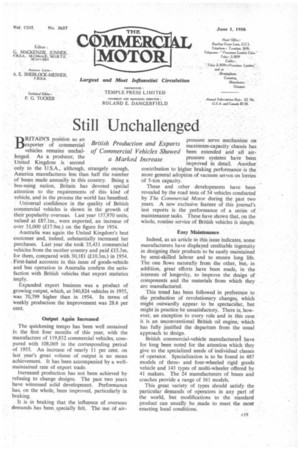Still Unchallenged
Page 69

If you've noticed an error in this article please click here to report it so we can fix it.
BRITAIN'S position as an exporter of commercial vehicles remains unchallenged. As a producer, the United Kingdom is second only to the U.S.A., although, strangely enough, America manufactures less than half the number of buses made annually in this country. Being a bus-using nation, Britain has devoted special attention to the requirements of this kind of vehicle, and in the process the world has benefited.
Universal confidence in the quality of British commercial vehicles is shown in the growth of their popularity overseas. Last year 157,970 units, valued at £87,1rn., were exported, an increase of over 31,000 (£17.9m.) on the figure for 1954.
Australia was again the United Kingdom's best customer and, indeed, substantially increased her purchases. Last year she took 35,431 commercial vehicles from the mother country and paid £13.3m. for them, compared with 30,181 (£10.3m.) in 1954. First-hand accounts in this issue of goods-vehicle and bus operation in Australia confirm the satisfaction with British vehicles that export statistics imply.
Expanded export business was a product of growing output, which, at 340,824 vehicles in 1955, was 70,799 higher than in 1954. In terms of weekly production the improvement was 28.6 per cent.
Output Again Increased The quickening tempo has been well sustained in the first four months of this year, with the manufacture of 119,832 commercial vehicles, compared with 108,069 in the corresponding period of 1955. An increase of nearly 11 per cent. on last year's great volume of output is no mean achievement. It has been accompanied by a wellmaintained rate of export trade.
Increased production has not been achieved by refusing to change designs. The past two years have witnessed solid development. Performance has, on the whole, been improved, particularly in braking.
It is ill braking that the influence of overseas demands has been specially felt. The use of air pressure servo mechanism on maximum-capacity chassis has been extended and all air Increase pressure systems have been improved in detail. Another contribution to higher braking performance is the more general adoption of vacuum servos on lorries of 5-ton capacity.
These and other developments have been revealed by the road tests of 54 vehicles conducted by The Commercial Motor during the past two years. A new exclusive feature of this journal's test reports is the performance of a series of maintenance tasks. These have shown that, on the whole, routine service of British vehicles is simple.
Easy Maintenance Indeed, as an article in this issue indicates, some manufacturers have displayed creditable ingenuity in designing their products to be easily maintained by semi-skilled labour and to ensure long life. The one flows naturally from the other, but, in addition, great efforts have been made, in the interests of longevity, to improve the design of components and the materials from which they are manufactured.
This trend has been followed in preference to the production of revolutionary changes, which might outwardly appear to be spectacular, but might in practice be unsatisfactory. There is, however, an exception to every rule and in this case it is an unconventional British oil engine, which has fully justified the departure from the usual approach to design. British commercial-vehicle manufactured have for long been noted for the attention which they give to the specialized needs of individual classes of operator. Specialization is to be found in 487 models of threeand four-wheeled rigid goods vehicle and 143 types of multi-wheeler offered by 41 makers. The 24 manufacturers of buses and coaches provide a range of 161 models.
This great variety of types should satisfy the particular demands of operators in any part of the world, but modifications to the standard product can usually be made to meet the most exacting local conditions.




























































































































































































































































